Mountains above Bunpoji Temple: Matsuosan and Shiragamidake

One of my favorite things about Sasayama is all of the mountains that are so very accessible and so full of history. Sasayama is literally surrounded by them. Today I’d like to write about just two of them. Fortunately for me I can get onto the mountain path that leads to them by walking only a few minutes from my house. But wherever you are in Sasayama, you will not be too far from the mountains.
I have been up to the top of the highest mountain in the immediate area, Shiragamidake, hundreds of times over the past 30 years and up the same mountain path to lower destinations countless times. What could be better for mental health and general well-being than an hour or two walking in Mother Nature. Along the way, you will discover the wonderful beauty of nature in Japan, as well as a lot of traces of local history. The following photo shows a friend from France on the top of Shiragamidake.
The main two mountains near me (in the Ajima area) are Matsuosan and Shiragamidake. (“San” means “mountain” and “dake” or “take” means “mountain” or “peak.”) There are two main access points, one from the Furoichi Station side and the other from the Sasayamaguchi Station side (my side). I always go up and down my side, but if you’re going over, you probably want to take a taxi from the Furoichi Station to the trail head because it’s quite a distance, whereas you can walk from the Sasayamaguchi Station to the trail head on my side (about 3 km). If you’re driving yourself, there is parking on both sides. There are some ups and down along the way, but the top of Shiragamidake is about 500 meters higher than the trail head. For those of you without mountain experience, that means it will be about 5°C colder and generally much windier at the top, so go prepared. There is no technical climbing involved, but there are some steep areas that might be a bit intimidating for the uninitiated. You definitely want good solid shoes.
A lot of mountains in Japan are associated with temples and shrines. And in my case, I access the trail head by going through the Bunpoji Temple Complex. The following photo shows the local shrine (Futamurajinja) that is just below the temple complex.
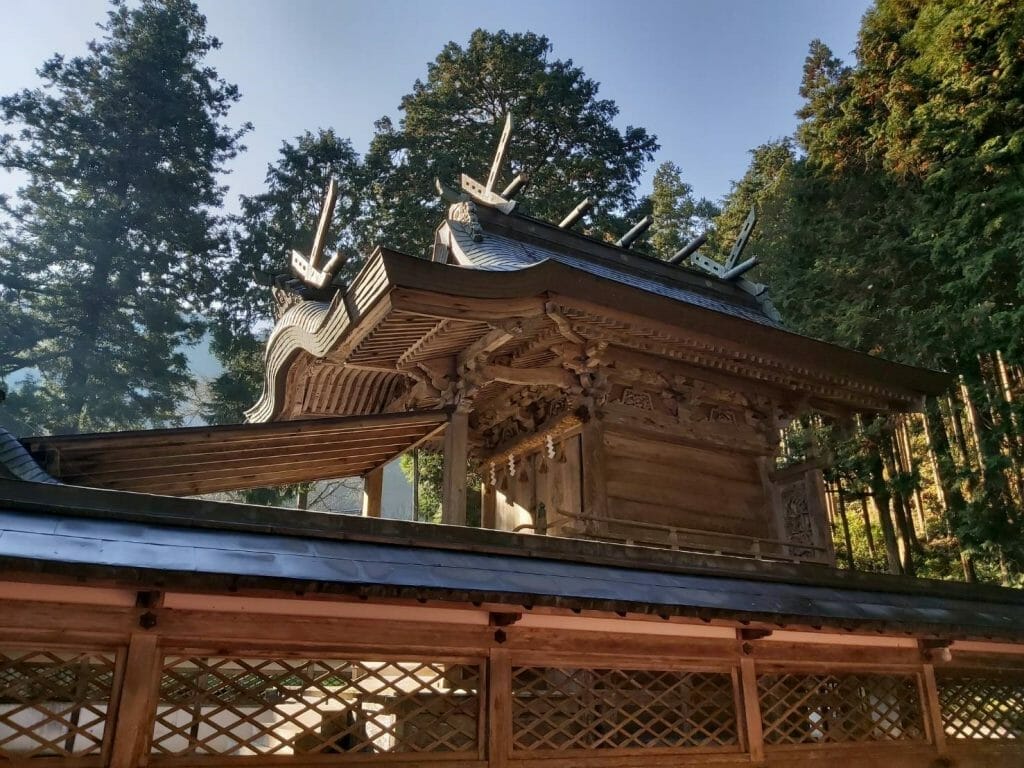
Mountains are traditionally considered sacred in Japan, the home of the gods and the source of food and water. In the country area, this feeling is still very much alive and well. It is part of the Shinto beliefs as a nature religion, which in some ways makes it similar to the religions of the native American Indians. Mountain names are also part of the official temple names, a custom imported from China.
One of the main reasons I like the local mountain paths above Bunpoji Temple is all the variety they offer. There are many different things to see and feel along the way. Many people think of mountain climbing only in terms of getting to the top, but the journey is often the best part. You’ll see areas with developed forestry that is well taken care of, such as in the following photo, and if you look very carefully to the sides of the trails, you’ll may even find an old tea field. (The tea plants will naturally grow to about 3 m in height; I’ve read of the period when tea leaves were picked by climbing the trees, but it was hard to imagine that until I saw the tall tea trees growing in the mountains.)

If you climb up to Matsuosan, which you’ll see the site of an old mountain fort, and then keep going for a ways down the other side (which is not the main way to Shiragamidake), you will find a secluded area that was inaccessible to logging, which served to preserve the older trees. The Japanese collectively call these “1,000-year cedar” to mean that they are very old. (It is not an estimate of their actual age.) Below is a photo of the main one, which splits into two trunks just above the ground level. There are also some other very old Japanese cedar in the same area.
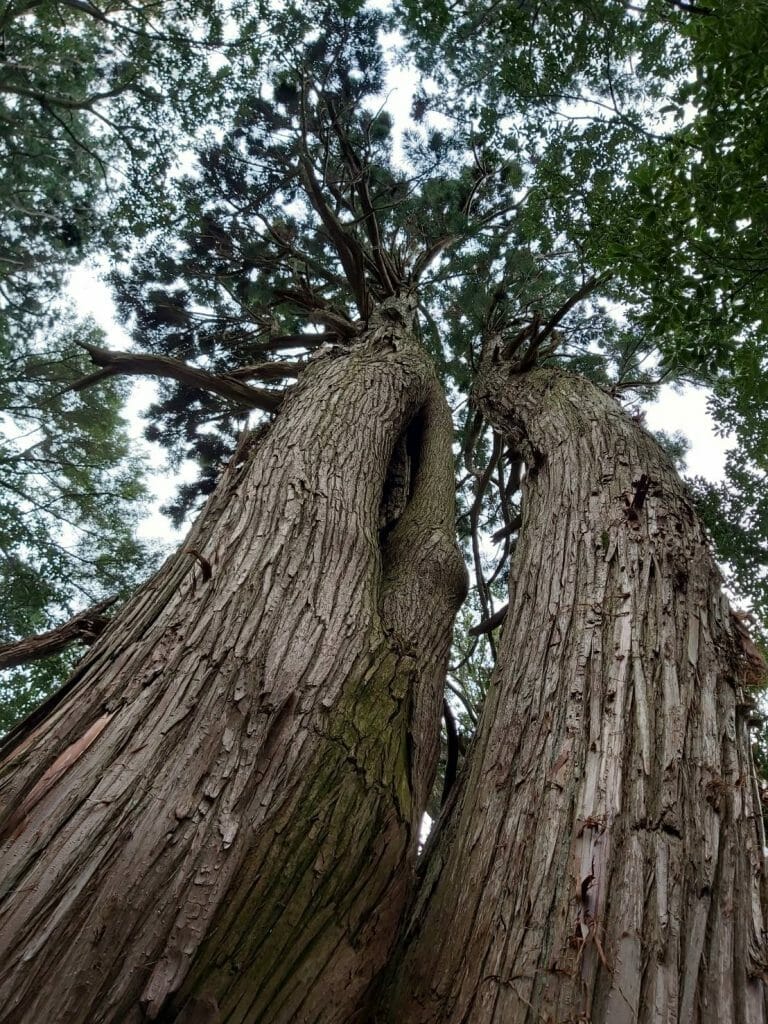
If you keep on going past the old cedar trees, you will find a lot of old remains in the mountains, including an area with several graveyards for Buddhist priests. (You can tell they are for priests from the shape of the head stones and writing on them.) Long ago, there was a very large temple in the area with road access from the other side. You can also find the old well for the temple and the old foundations of mountain forts.
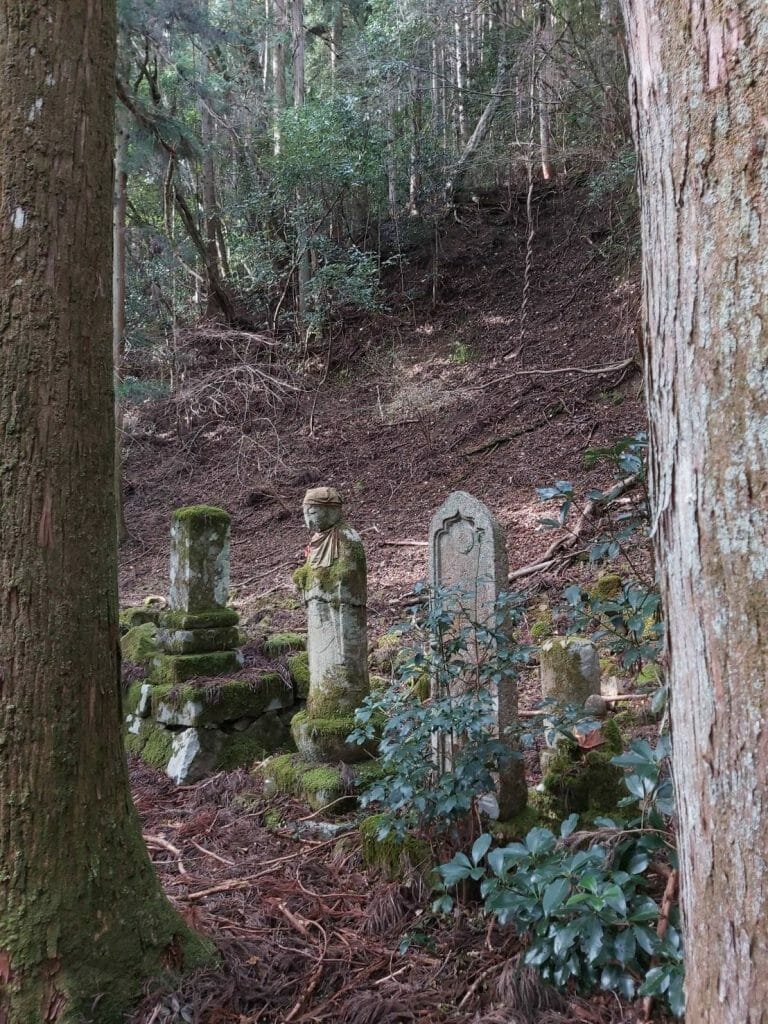
The following photo shows the old embankment for the road to the temple, long ago covered in moss.
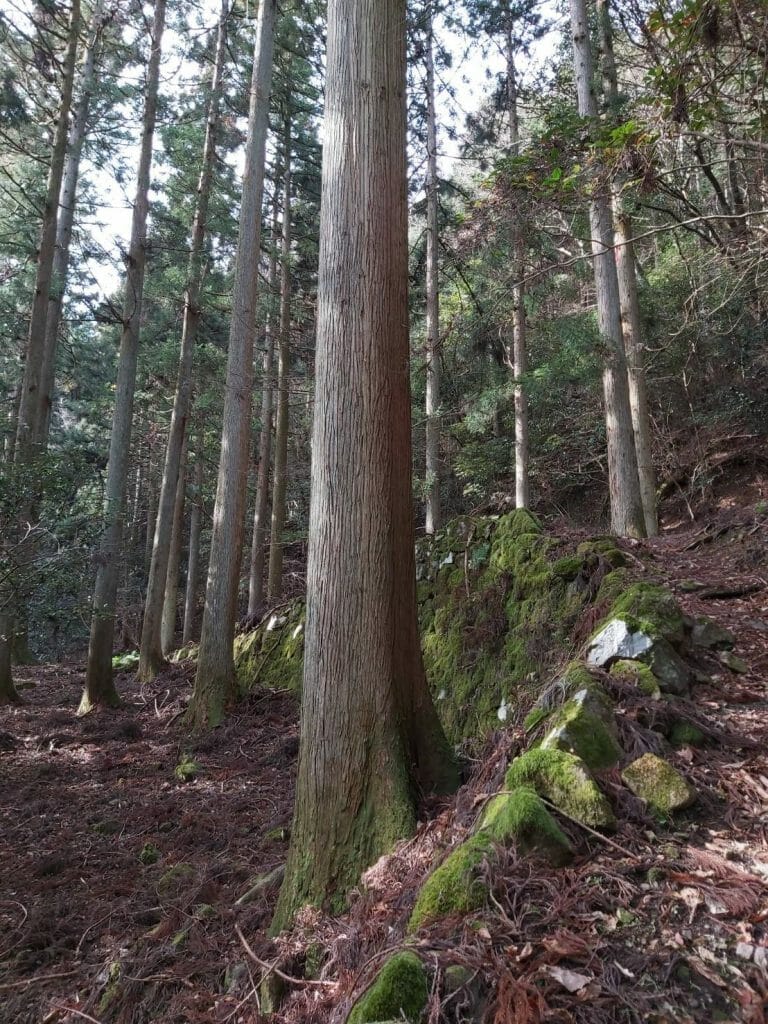
And this is an old road marker with Sanskrit characters. (Sanskrit is used on graves and other places in Buddhism.)
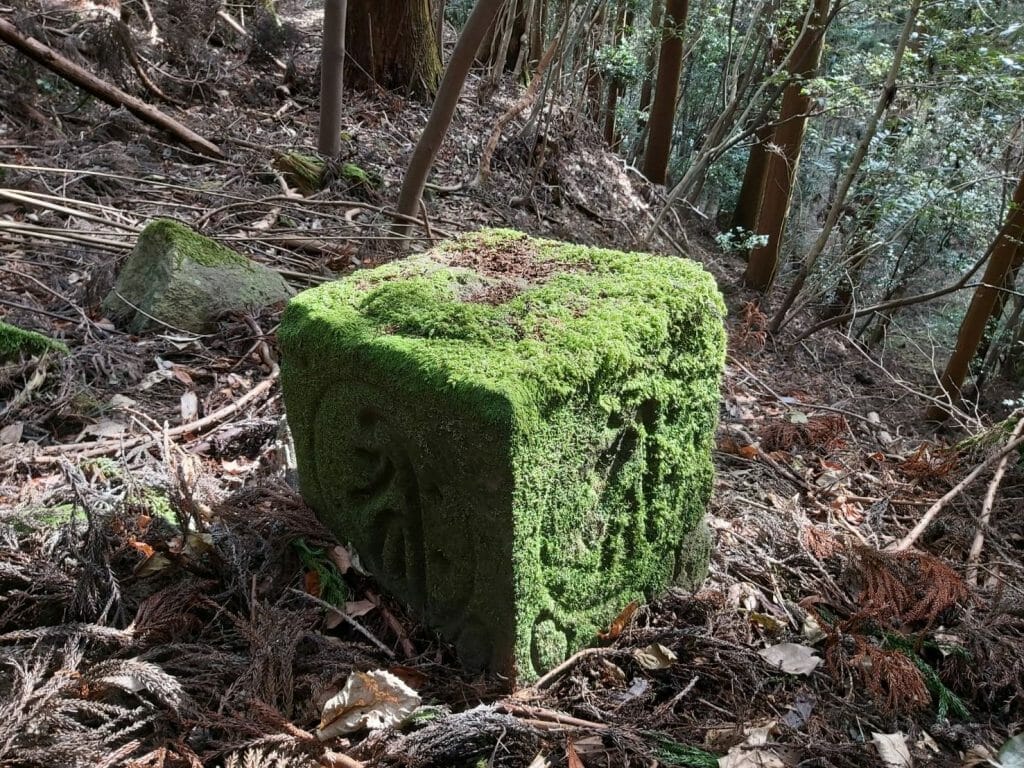
And if you’re lucky, you might even find something for lunch. (You’re on your own with mushrooms. You see a lot of them with the very damp environment in Japan—there are tens of thousands of varieties, but keep in mind that many are not edible.)

And you’ll see a lot of other plant life of all sorts that change with the seasons. Not all of them are that friendly, as the bottom photo below shows.
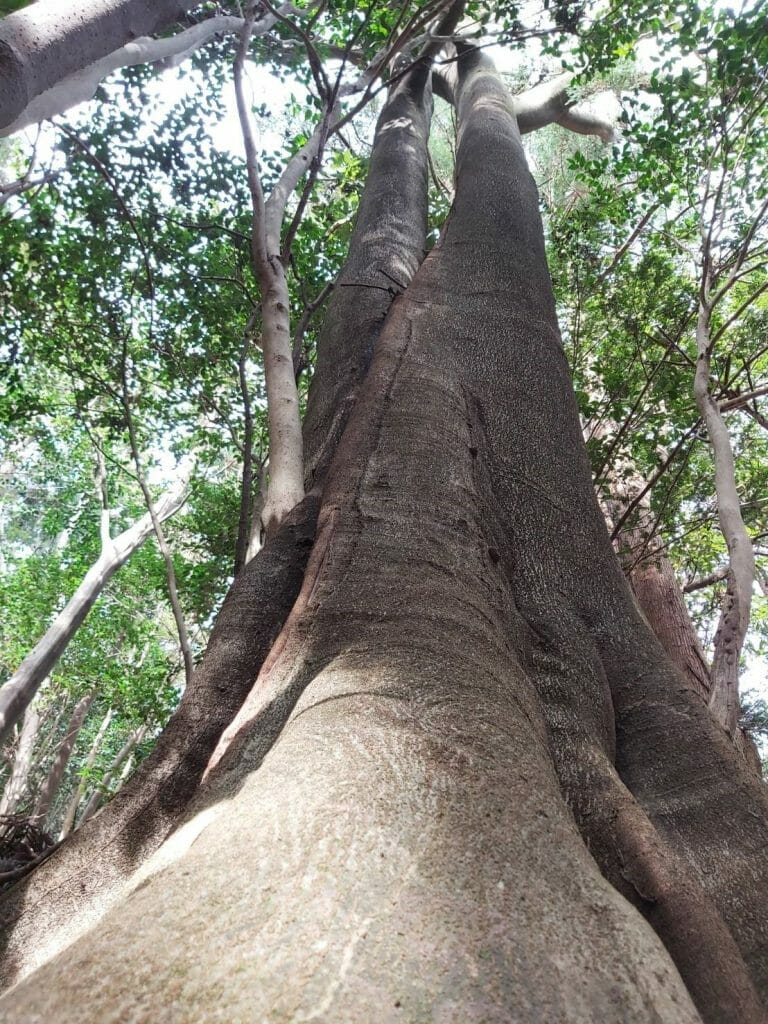
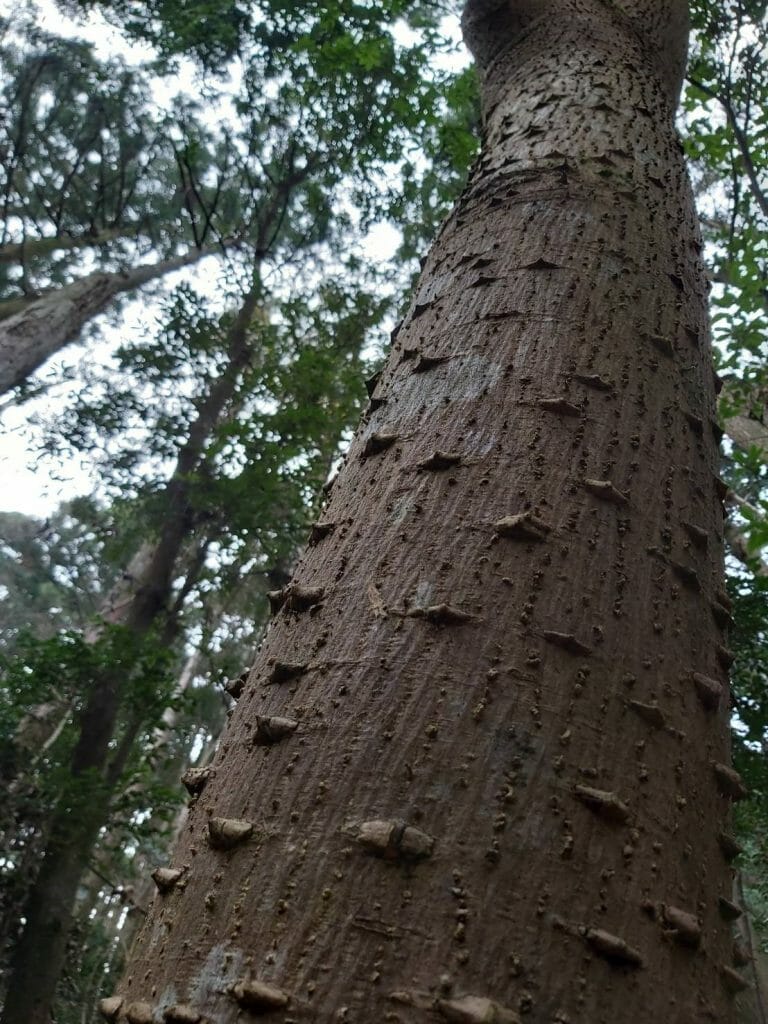
As for wildlife, you’ll have to be lucky to see very much. Even with all of the times I’ve been up in the local mountains, I’ve seen wild boar only three times and I’ve yet to see a bear, even though they are occasionally spotted. You do see deer, but generally just the white tails, as well as squirrels. There are no monkeys in our area, but there are mountains on the other side of Sasayama where they are seen all of the time. (They don’t make very good playmates, so educate yourself on monkeys before you go hunting for them.)
WARNING:
When you’re in the mountains, you don’t want to make a monkey, bear, or wild boar angry, particularly if they have cubs with them, but that’s pretty obvious. But there are two types of poisonous snakes in Sasayama (and most of the Main Island): Yamakagashi (Rhabdophis tigrinus) and Mamushi (Gloydius blomhoffii). Yamakagashi are very poisonous, but you pretty much have to stick your finger into their tiny mouths to get bitten. You don’t need to worry too much about these guys as long as you don’t tease them or anything, and they have very pretty patterns in yellow or red on their necks. We see them around our yard frequently. My cat has even brought live ones into the house to play with.
The Mamushi are a different story. They are not going to go out of their way to bite you, but if they feel threatened, they can become aggressive. They tend to hid, so you’re not likely to see them if you’re not looking carefully, but if you put you hand on one hidden in the grass when you’re climbing or step on one, it will bite. They often hid in depressions in the trail, and people get bitten when they step on them, but it’s always a good idea to watch where your stepping in the mountains for several reasons. Mamushi are actually not as poisonous as the Yamakagashi, but you do want to get medical attention immediately. (There are only a few fatalities in Japan for about 3,000 bites each year.) Before you go to the mountains anywhere in Japan (and the same thing applies in other countries), you should learn to identify these snakes. There are also black snakes and striped snakes in the area. You see them pretty commonly, but they are not poisonous and therefore pretty harmless
The most dangerous thing in nature in Japan, statistically speaking, are the Suzumebachi hornets (Vespa mandarinia or “Asian giant hornet”). You will not have any trouble spotting them: they are huge. The native Japanese variety is large enough, but a recent import from mainland Asia is even larger. A couple dozen people die every year from their stings. Many of those stings did not occur in the mountains, but if you get stung in the mountains, it will be some time before you can get medical treatment, so be careful.
Just like snakes, a hornet is not going to go to any trouble to sting you (they have better things to do), but if you disturb their hive, they will swarm out to protect it. Known hives are sometimes marked in the mountains with warning signs, but if you see more than a couple hornets in the same area, you’re probably near a hive and should quietly move away. (Running from any wild animal, including things like hornets, is counterproductive. It can cause them to chase you, and you cannot outrun them.)
Hornet hives can be high in trees, in fallen logs, in rock crevices, or in the ground. I even saw one hanging in the middle of a large boulder in a dry river bed. I’m not trying to scare anyone. If you practice common sense in the mountains, you’ll be just as safe as you are crossing the highway. (Consider how dangerous that would be if you threw out common sense and crossed against the light.) So, here’s hoping to meet some of you in the mountains around Sasayama.














